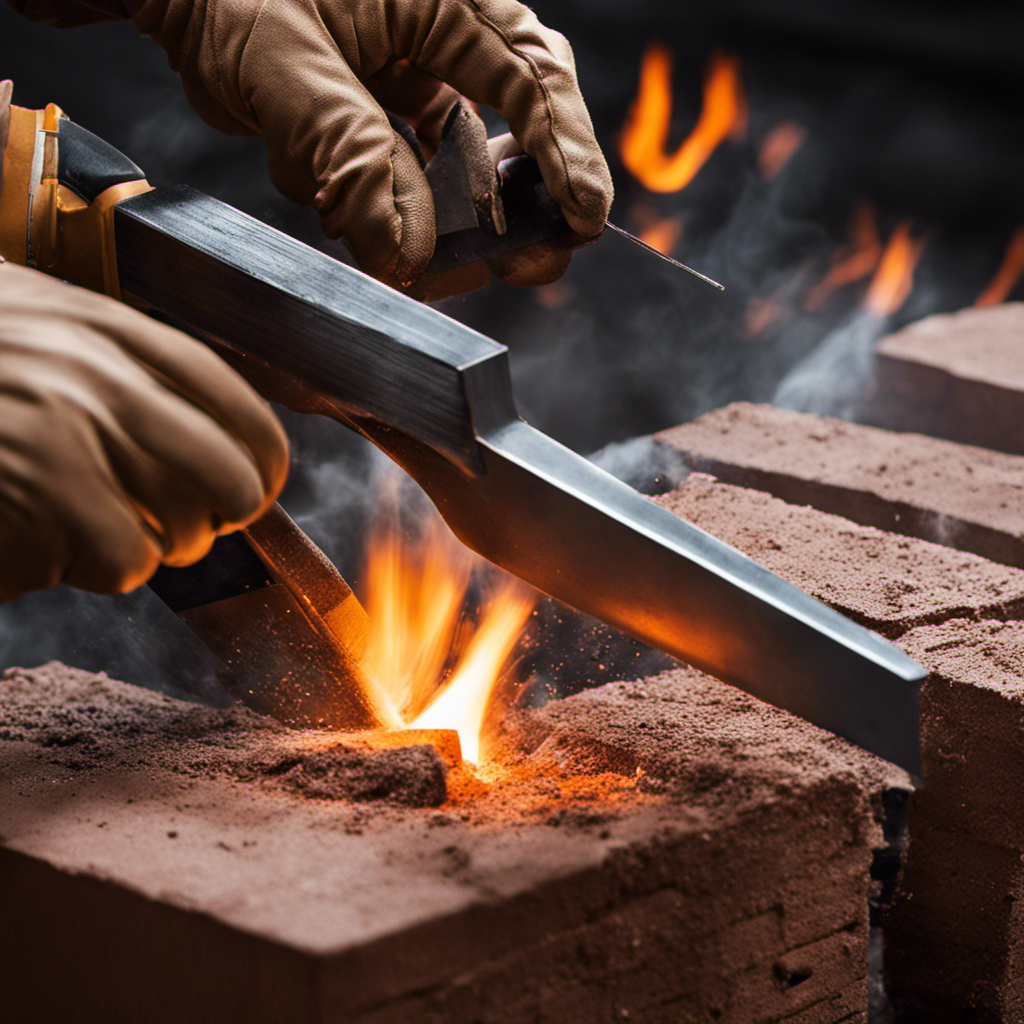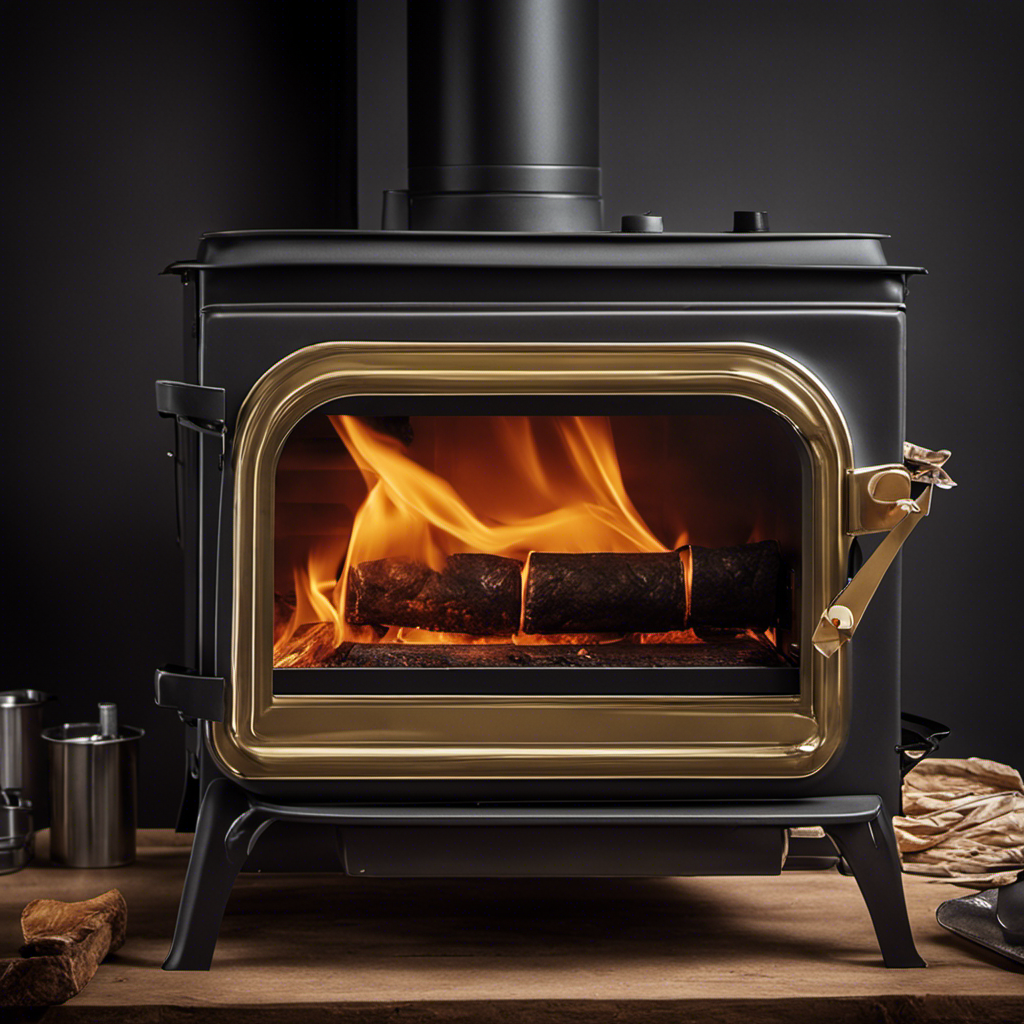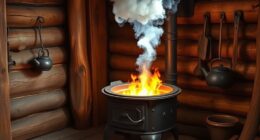Hello DIY enthusiasts!
Ready to learn a handy skill for your wood stove? In this article, I’ll show you how to cut fire bricks like a pro.
With just a few tools and some precise measurements, you’ll be able to customize those bricks to fit your stove perfectly. Trust me, it’s easier than it sounds.
So let’s roll up our sleeves and get started on this satisfying project!
Key Takeaways
- Use the proper tools and safety gear, such as a diamond blade, wet saw, safety goggles, gloves, and a dust mask.
- Clean and inspect the fire bricks before cutting, and select the appropriate sizes for the wood stove.
- Measure and mark the dimensions accurately on the bricks, emphasizing precision and following safety precautions.
- Cut the bricks along the marked lines using a masonry chisel or diamond blade, applying steady pressure and wearing protective gear.
Tools and Materials Needed
I always use a diamond blade and a wet saw to cut fire bricks for my wood stove.
When it comes to selecting the right tools for cutting fire bricks, safety is a top priority. It’s important to choose a diamond blade that’s specifically designed for cutting masonry materials like fire bricks. This type of blade is durable and can withstand the heat generated during the cutting process. Additionally, using a wet saw is essential as it helps to reduce dust and keeps the blade cool, preventing it from overheating.
As for safety precautions, it’s crucial to wear protective gear such as safety goggles, gloves, and a dust mask to shield yourself from any potential hazards.
When it comes to shaping fire bricks, the best technique is to use a grinder with a masonry wheel. This allows for precise cuts and helps achieve the desired shape easily.
Always remember to take your time and work slowly when cutting and shaping fire bricks to ensure accuracy and safety.
Preparing the Fire Bricks
To ensure the bricks are ready for use, it’s important to carefully clean and inspect them before placing them in the wood stove. Preparing fire bricks involves a few essential steps:
- Clean the bricks thoroughly to remove any dirt, dust, or debris.
- Inspect the bricks for any cracks or damage that may affect their performance.
- Select fire brick sizes that are appropriate for your wood stove, ensuring a snug fit.
- Stack the bricks in a well-ventilated area to allow them to dry completely.
- Arrange the bricks in the wood stove, making sure they’re securely placed and ready for use.
By following these steps, you can ensure that your fire bricks are in optimal condition for your wood stove, providing efficient heat and a safe burning environment.
Now, let’s move on to the next step: marking and measuring for cutting the fire bricks.
Marking and Measuring
First, measure the length and width of the fire brick, and then mark the dimensions for an accurate cut.
When cutting fire bricks for a wood stove, it’s essential to use proper measuring techniques to ensure a precise fit. Start by using a tape measure to determine the length and width of the brick. Take accurate measurements and write them down for reference.
Once you have the dimensions, it’s time to mark the brick. Use a pencil or a marker to draw lines on the brick, indicating where you need to make the cut. It’s important to be precise with your markings to avoid any mistakes.
Additionally, always remember to follow safety precautions when working with tools and wear protective gear, such as gloves and goggles, to prevent any injuries.
Cutting the Fire Bricks
When cutting the fire bricks for my wood stove, I need to carefully measure and mark the dimensions for an accurate cut. Cutting fire bricks requires specific techniques to ensure safety and precision. Here are some important things to consider:
- Use a straight edge or a square to mark the dimensions on the brick.
- Score the brick along the marked line using a masonry chisel or a diamond blade on an angle grinder.
- Apply steady pressure while cutting to avoid any sudden movements that could cause the brick to break unevenly.
- Wear safety goggles and gloves to protect yourself from flying debris and sharp edges.
- Take breaks if necessary to avoid fatigue, as it can affect your accuracy and concentration.
Finishing and Installing the Cut Bricks
I’m ready to finish and install the cut bricks for my wood stove. After successfully cutting the fire bricks to the desired size, the next step is to install them properly.
When it comes to installing techniques, it’s crucial to ensure a secure and stable placement of the bricks. Firstly, I’ll clean the area where the bricks will be installed, removing any debris or dust.
Then, I’ll apply a layer of refractory cement on the surface to create a strong bond between the bricks and the stove. It’s important to follow the manufacturer’s instructions for the cement application.
Additionally, sealing the bricks is essential to prevent any air leakage or heat loss. I’ll carefully inspect the joints between the bricks and use a heat-resistant sealant to create a tight seal.
Frequently Asked Questions
How Long Does It Typically Take to Cut Fire Bricks for a Wood Stove?
Typically, it takes me about 15-20 minutes to cut fire bricks for my wood stove. To ensure efficiency, I choose the right tools for cutting and regularly maintain their sharpness.
Can Fire Bricks Be Cut Using a Regular Saw?
Yes, fire bricks can be cut using a regular saw. However, it is recommended to use a masonry saw with a diamond blade for better precision and to prevent damage to the brick.
Is It Necessary to Wear Protective Gear While Cutting Fire Bricks?
It is not safe to cut fire bricks without wearing protective gear. The potential hazards of cutting fire bricks without protective gear include inhaling harmful dust particles and risking injury from flying debris.
Can Fire Bricks Be Cut Into Different Shapes Besides Rectangular?
Yes, fire bricks can be cut into different shapes besides rectangular. There are various cutting techniques available depending on the desired shape, such as using a wet saw or diamond blade.
What Are Some Common Mistakes to Avoid When Cutting Fire Bricks for a Wood Stove?
When cutting fire bricks for a wood stove, it’s important to avoid common mistakes. Tips for efficient cutting include using a proper saw, measuring accurately, and taking safety precautions.
Conclusion
Cutting fire bricks for a wood stove may seem daunting, but with the right tools and technique, it can be done easily. By following the steps outlined in this article, you’ll be able to prepare, measure, and cut the fire bricks with precision.
Remember, practice makes perfect, so don’t be discouraged if your first attempt isn’t flawless. With a little patience and determination, you’ll be able to finish and install the cut bricks, improving the efficiency and performance of your wood stove.











